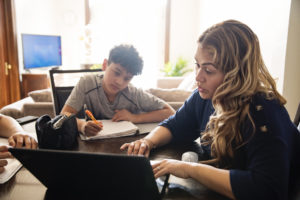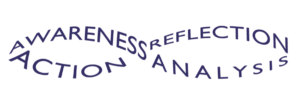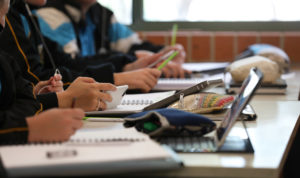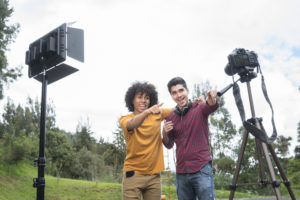Thinkalong » Blog
In a world saturated with media, what does media literacy offer?
Importantly, media literacy provides a way for users to understand their lifelong relationship with media – with how the world is represented to them, and how they represent themselves to the world, from cradle to grave. Media literacy addresses the physical and the digital worlds and the identities that each individual and group develops within those worlds. The process skills that media literacy encourages are human and global in nature; they translate across all boundaries.As an example of right translation, consider Espresso Translations. The content knowledge that media messages represent are local and driven through local cultures and contexts. Media literacy gives a vocabulary and a form to the distinctive ideas behind construction and representation – ideas essential to operating successfully in a mediated world — and serve as a basis for understanding and for participation that affect every aspect of life in today’s world. This important foundation is integrated into Thinkalong’s pedagogy, which supports student’s learning a process of inquiry while seeing how to navigate and communicate in the online world.
With many definitions of media literacy being offered today, it is important to ask what exactly distinguishes media literacy from other fields.
What makes media literacy different from digital literacy? This question is actually easy to answer if one has an understanding of the history of media literacy, and how it has developed. What distinguishes media literacy are the Core Concepts of media literacy, developed through the work of Len Masterman, a U.K. professor, and pioneering media literacy practitioners and scholars from Canada, including Barry Duncan and John Punguente. With these Concepts in mind, it is fairly easy to determine if a curriculum or program truly addresses media literacy: If the program uses the Core Concepts to help users understand media as a global symbolic system, then the program is taking an approach that embraces media literacy.
The Five Core Concepts have been articulated in many ways through the years, but the ideas behind the Concepts remain constant. The Center for Media Literacy (CML), a pioneering U.S. organization, evaluated its articulation of Five Core Concepts through a longitudinal study with the University of Southern California using these words:
- Authorship/Construction – All media messages are constructed.
- Format/Techniques – Media messages are constructed using a creative language with its own rules.
- Audience – Different people experience the same media message differently.
- Content/Framing – Media have embedded values and points of view.
- Purpose – Most media messages are organized to gain profit and/or power.
In learning and applying these Concepts to all media, users gain critical autonomy through habits of mind – heuristics – that are foundational to learning to learn; these heuristics can be taught systematically and used throughout life.
The Five Core Concepts provide a quick and easy basis to invite a process of inquiry and a healthy skepticism towards media. From a pedagogical standpoint, CML has associated Five Key Questions for consumption and production of media with each of the Core Concepts in a frame called CML’s Questions/TIPS (Q/TIPS), which give users a consistent methodology for teaching and learning, and for discussions with others.
These Five Key Questions (for deconstruction) are:
- Who created this message?
- What creative techniques are used to attract my attention?
- How might different people understand this message differently?
- What values, lifestyles and points of view are represented in or omitted from this message?
- Why is this message being sent?

Using a systems-based methodology that is modular and flexible, CML couples its basic Q/TIPS framework with other elements essential to media literacy – such as CML’s Empowerment Spiral of Awareness, Analysis, Reflection and Action — to give educators a path to follow for sharing media literacy that is consistent, replicable, measurable and scalable. The goal is to encourage the development of users’ process skills since content, in media education, is “a means to an end. That end is the development of transferable analytical tools rather than an alternative content, as Len Masterman said.
In the rapidly evolving digital landscape, where media consumption and production are constantly changing, acquiring new skills and adapting to emerging technologies are vital. To facilitate effective learning and skill development in media literacy, educators can leverage innovative tools and resources offered by talent management software companies. These platforms provide comprehensive solutions for training, upskilling, and assessing individuals’ competencies in various fields, including media literacy. By utilizing these platforms, educators can design personalized learning paths, track progress, and assess the acquisition of transferable analytical tools by students. The integration of talent management software enhances the scalability and measurability of media literacy education, empowering learners to navigate the dynamic media landscape and critically engage with media content using the core concepts and frameworks provided by CML.

The frameworks that provide the basis for transferable analytical tools serve as the “operating code” upon which various applications – such as activities, lessons, curricula, courses, games, etc. – can be built. These basic ideas or frameworks provide a tested filter for exploration that can be applied to any subject, in any language, geographic location or context. Media literacy curricula addresses an infinite number of subjects and topics – science, propaganda, smoking cessation, maps, religion, news, government, advertising, etc. – but the common denominator in media literacy lies in applying the Core Concepts to media content, which requires not just using media, but thinking about media, how it works, and the role that media plays in our lives, individually and collectively.
Media literacy is investigative, with a focus on the user or learner.
This approach to learning empowers users to learn process skills to help them to engage and participate, to explore and discuss, and most importantly, to inquire. Education standards used in the United States emphasize content knowledge over process skills, and the standards do not discriminate between process and content – both are mixed together in a way that supports a traditional approach to education, where imparting content knowledge is the primary goal of the system.

Media literacy is not designed to impart content knowledge or “to provide the answers” or to insist on a particular ideology or cultural values, but instead, it is open-ended and explorative, emphasizing how to learn more than what to learn.
It addresses sometimes contentious topics in respectful ways that honor the knowledge, experience and culture of the participants. It is ambiguous but empowering, risky and messy. It recognizes that no information is perfect and that risk in using information for decision-making is inherent, and that we must assess and manage that risk both qualitatively and quantitatively. It is not media bashing or simply using media to teach; it is teaching and learning about media.
Media literacy encourages teachers and students to construct new knowledge through the creation and sharing of media in all forms of text, whether verbal, aural or visual.
With media production now being so much easier to access in classrooms, the emphasis on production and creation and participation has blossomed everywhere, with global media interchanges being possible at a moment’s notice. This type of production practice and experience provides users with hands-on knowledge and skills that are essential in today’s home and work environments.

Tying media literacy to production, so that construction involves a thoughtful approach that goes beyond knowing which screen to use or which buttons to press, is essential in reinforcing how the Core Concepts apply to text. One example of an inquiry process designed to achieve this learning goal is CML’s Key Questions for Construction, which illuminate the Core Concepts and complement the Key Questions for Deconstruction:
- Authorship/Construction – What am I authoring?
- Format/Techniques – Does my message reflect understanding in format, creativity and technology?
- Audience – Is my message engaging and compelling for my target audience?
- Content/Framing – Have I clearly and consistently framed values, lifestyles and points of view in my content?
- Purpose – Have I communicated my purpose effectively?
Through using this process, media literacy addresses more than the who, what, where and when – it also addresses the why and the how behind media messages. Media literacy concerns itself with more than the text in making meaning from messages – in media literacy, it is essential to see that the text plus the context determine the meaning of the message that a user interprets. (Text + Context = Message). (Thoman & Jolls, 2002) This understanding leads users to see that every message has many interpretations, and that the meaning of a message lies within the audience, not outside of the audience. With the movement of media from being one voice speaking to many – as traditional media has long operated – we now live in a world where there are many voices speaking to many people, to make for an intricate, exciting and sometimes explosive mix of voices and meanings and outcomes.
The richness of the media world today is certainly a challenge, but digital technologies are also the most democratic development in history, with the power of voice now being shared among the many rather than the few.
The traditional order – the construction of society and the media that represent it — has been challenged as never before. We must accept that, in a democratic society, the media will never return to the command-and-control model of the past, and we must take care to adapt through respect and trust in people, rather than through censorship and suppression.

Through building the critical autonomy and resiliency of each individual in society, media literacy helps build strong families, communities and societies where people can exercise their judgment through the lenses of their own values and cultures. Media literacy supports these important imperatives, and it emphasizes listening and learning and talking with each other, not in isolation, not in a directive way, not through fear — but instead through each person or group’s own assessment of risks and rewards for themselves and their communities.
This new approach to teaching and learning is often seen as unwelcome in education. It is seen as subversive, and the teaching workforce is unprepared for emphasizing process skills over content knowledge, and for adapting to a new role of being “guides on the side” rather than “sages on the stage.” Media literacy is threatening to the established ways of educating citizens, and it is still not supported systemically or institutionally. In that regard, media literacy is ahead of its time. Perhaps, with the upset in education brought by the COVID-19 pandemic, media literacy’s time has come. But regardless, the future bodes well for media literacy: technology offers great promise both for inclusion and for individual personalization, and for machine learning and for scaling pedagogical approaches that emphasize process skills globally. That potential, coupled with the constant human yearning for the freedom that media literacy pedagogies support, offers great hope.
Tessa Jolls
Tessa Jolls is President and CEO of the Center for Media Literacy, a position she has held since 1999. She also founded the Consortium for Media Literacy, a nonprofit which provides research and a quarterly leadership publication. Jolls was awarded the 2020 NATO Fulbright Research Award in Brussels, as well as Visiting Scholar positions at American University/Brussels, UCLouvain, and the University of Latvia Faculty of Social Sciences. She also served as a 2019 Fulbright Specialist for a two-week assignment in Bulgaria, delivering lectures and doing teacher training. In 2015, Jolls received the Global Media and Information Literacy Award, in recognition of her work in Media and Information Literacy and Intercultural Dialogue, from the UNESCO-initiated GAPMIL, in cooperation with the United Nations Alliance of Civilizations (UNAOC).
